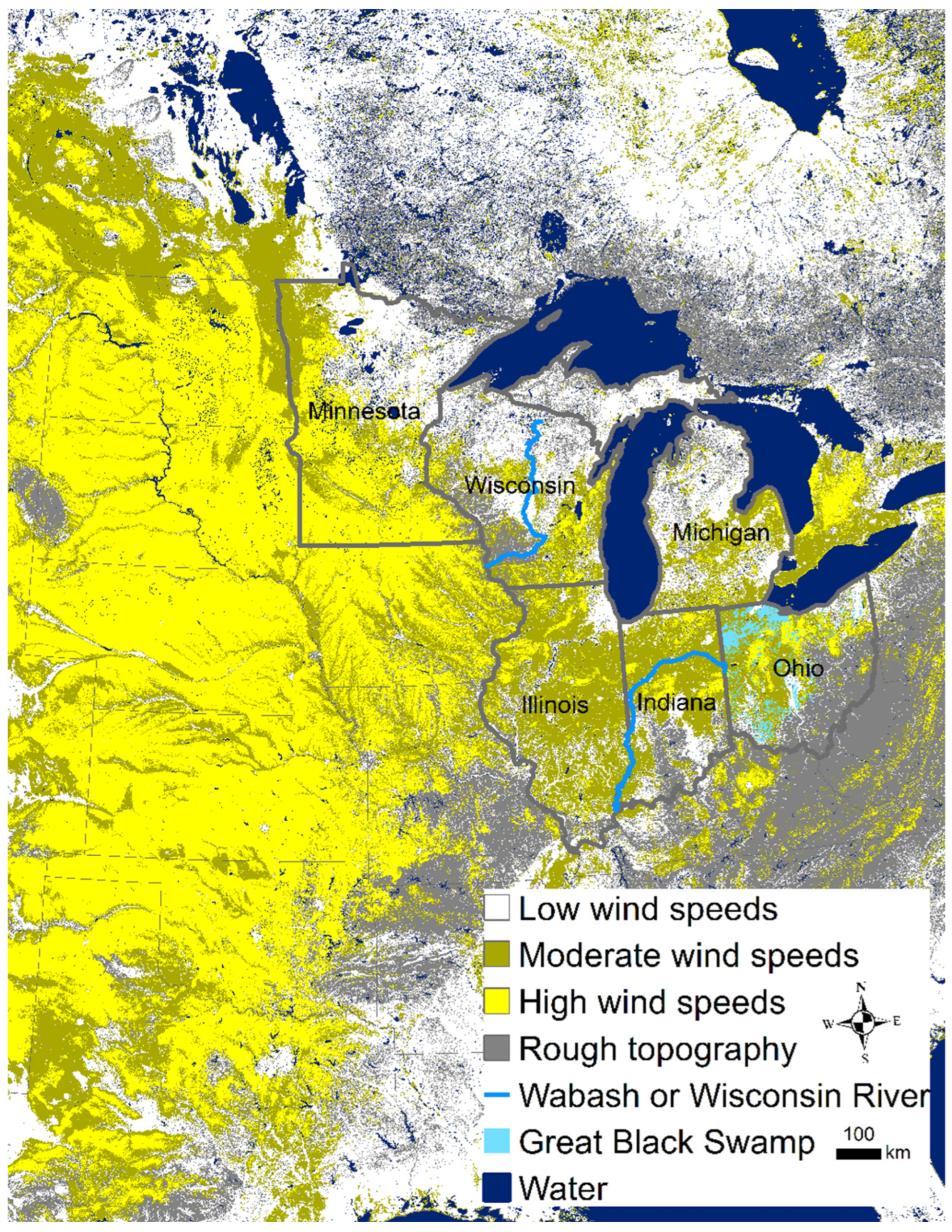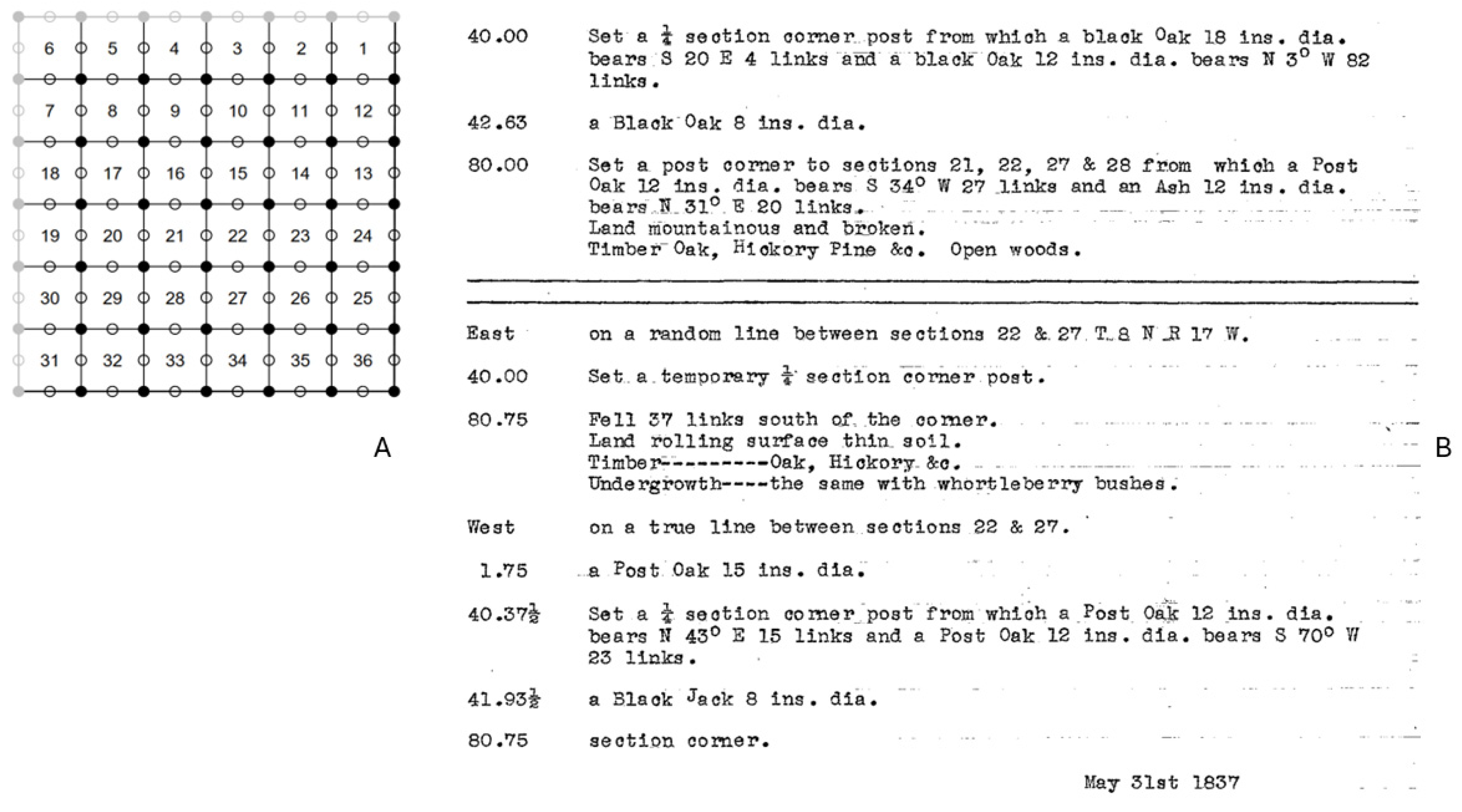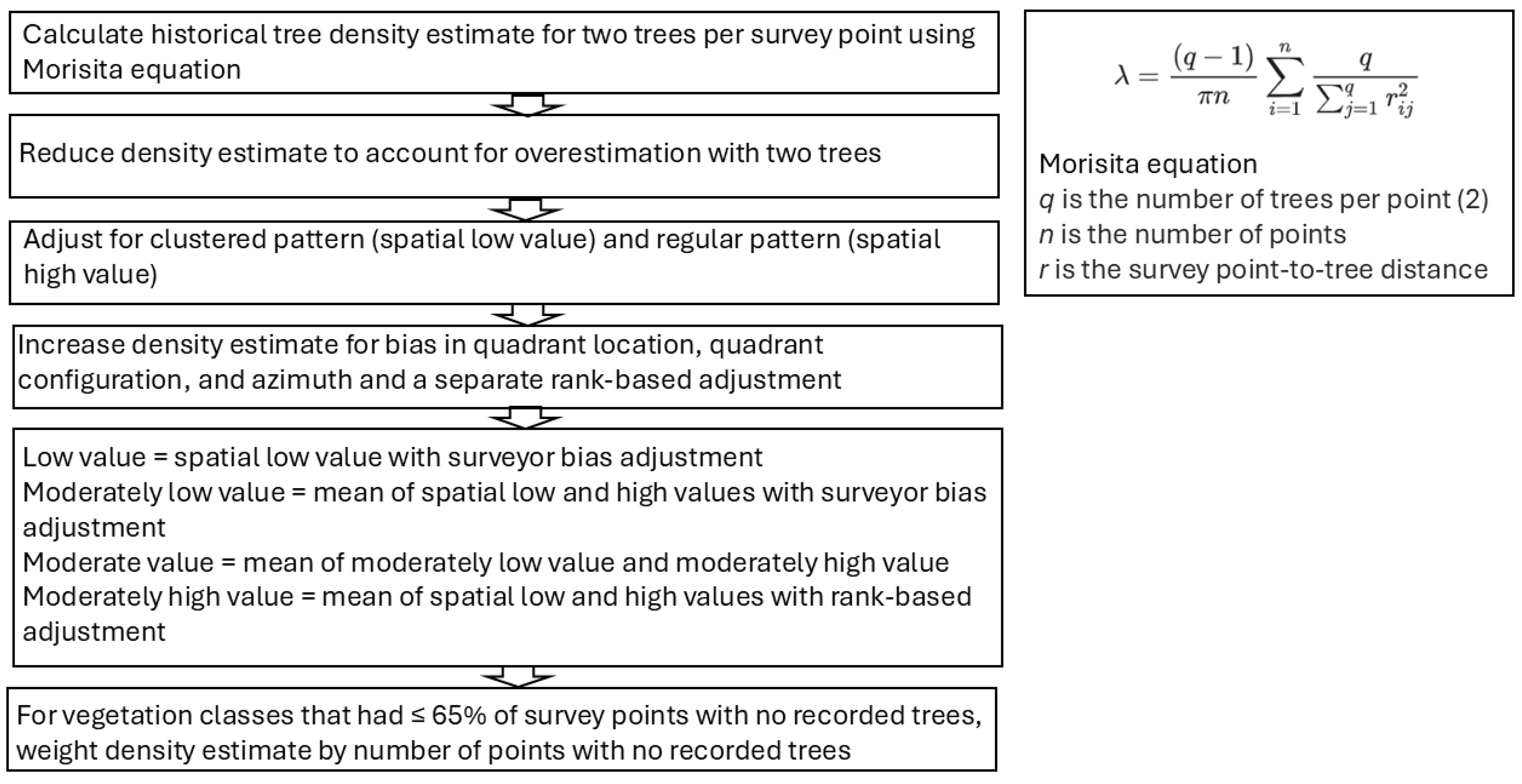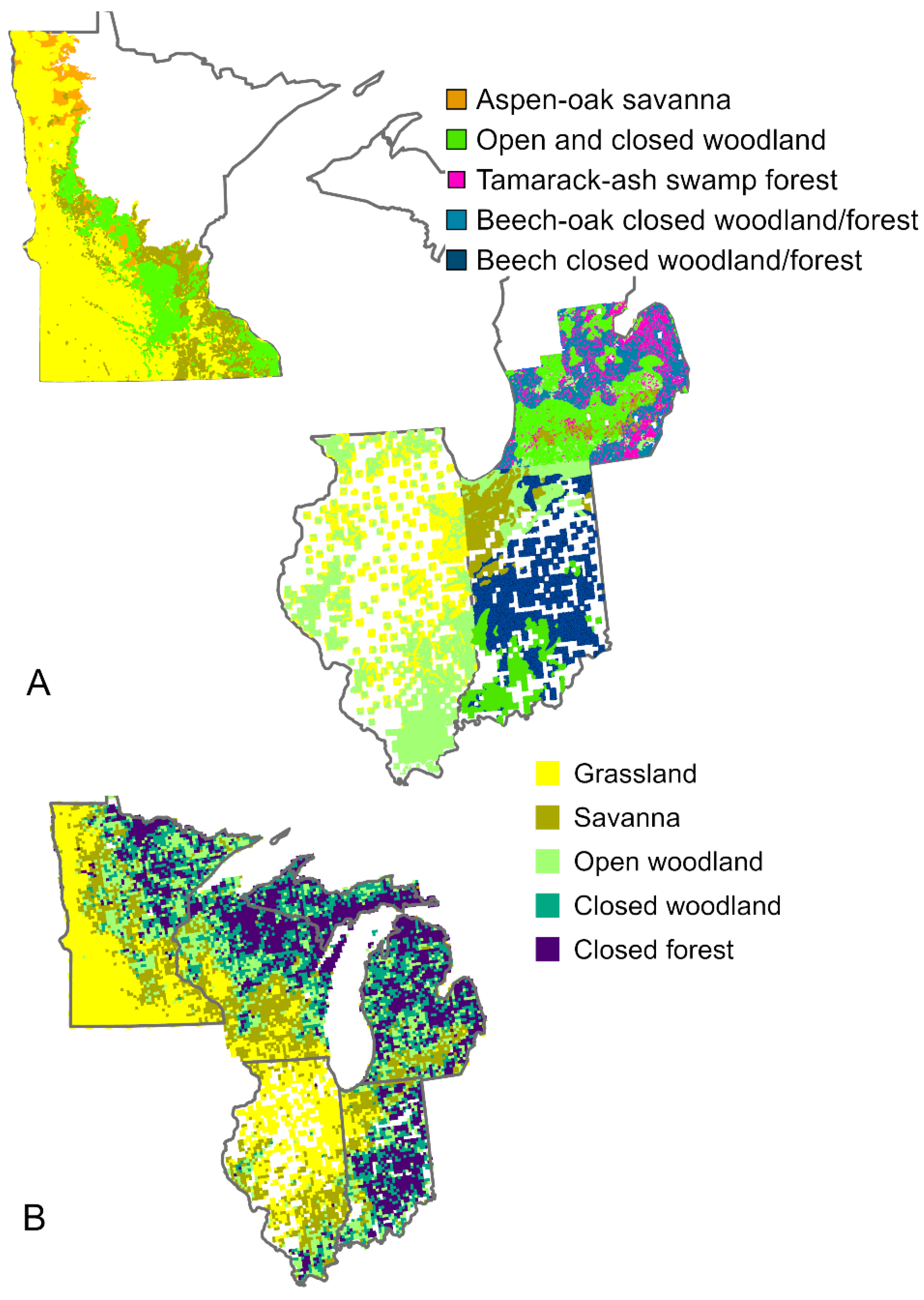Contextualizing Estimated Tree Densities and Expert-Classified Ecosystems in the Historical Midwestern United States, a Region with Exposure to Frequent Fires
Abstract
:1. Introduction
2. Materials and Methods
3. Results
3.1. Density Estimates and Ecosystem Classes by Vegetation Classes
3.2. Overlap with Modeled Density Estimates by Vegetation Types
3.3. Overlap with Density Estimates for Illinois, Indiana, and Southern Michigan
4. Discussion
4.1. Key Outcomes
4.2. Considerations for Applying Density Estimates to Ecosystems
4.3. Contextualizing Density Estimates and Vegetation Classes
5. Conclusions
Author Contributions
Funding
Data Availability Statement
Acknowledgments
Conflicts of Interest
References
- Bragg, D.C.; Hanberry, B.B.; Hutchinson, T.F.; Jack, S.B.; Kabrick, J.M. Silvicultural options for open forest management in eastern North America. For. Ecol. Manag. 2020, 474, 118383. [Google Scholar] [CrossRef]
- Hagmann, R.K.; Hessburg, P.F.; Prichard, S.J.; Povak, N.A.; Brown, P.M.; Fulé, P.Z.; Keane, R.E.; Knapp, E.E.; Lydersen, J.M.; Metlen, K.L.; et al. Evidence for widespread changes in the structure, composition, and fire regimes of western North American forests. Ecol. Appl. 2021, 31, e02431. [Google Scholar] [CrossRef] [PubMed]
- Peck, J.M. A Gazetteer of Illinois. 1834. Available online: https://www.siue.edu/lovejoy-library/tas/Abbott_722.pdf (accessed on 17 November 2023).
- Engelmann, H. Remarks upon the causes producing the different characters of vegetation known as prairies, flats, and barrens in southern Illinois, with special reference to observations made in Perry and Jackson counties. Am. J. Sci. 1863, 86, 384–396. [Google Scholar] [CrossRef]
- Heikens, A.L.; Robertson, P.A. Barrens of the Midwest: A review of the literature. Castanea 1994, 59, 184–194. [Google Scholar]
- McClain, W.E.; Ruffner, C.M.; Ebinger, J.E.; Spyreas, G. Patterns of anthropogenic fire within the midwestern tallgrass prairie 1673–1905: Evidence from written accounts. Nat. Areas J. 2021, 41, 283–300. [Google Scholar] [CrossRef]
- Beckwith, H.W. History of Vigo and Parke Counties, Together with Historic Notes on the Wabash Valley, Gleaned from Early Authors, Old Maps and Manuscripts, Private and Official Correspondence, and Other Authentic, Though, for the Most Part, Out-of-the-Way Sources. 1880. Available online: https://babel.hathitrust.org/cgi/pt?id=uiug.30112045819148&view=1up&seq=7 (accessed on 17 November 2023).
- Gaskill, A. Why prairies are treeless. Science 1905, 22, 55–56. [Google Scholar]
- Gleason, H.A. The relation of forest distribution and prairie fires in the Middle West. Torreya 1913, 13, 173–181. [Google Scholar]
- Transeau, E.N. The prairie peninsula. Ecology 1935, 16, 423–437. [Google Scholar] [CrossRef]
- Williams, D.L. Reconstruction of prairie peninsula vegetation and its characteristics from descriptions before 1860. Ohio Biol. Surv. Biol. Notes 1981, 15, 83–86. [Google Scholar]
- Chapman, K.A.; Brewer, R. Prairie and savanna in southern lower Michigan: History, classification, ecology. Mich. Bot. 2008, 47, 1–48. [Google Scholar]
- Hanberry, B.B. Timing of tree density increases, influence of climate change, and a land use proxy for tree density increases in the eastern United States. Land 2021, 10, 1121. [Google Scholar] [CrossRef]
- Hanberry, B.B. Wind-bounded grasslands of North America. Ecol. Indic. 2021, 129, 107925. [Google Scholar] [CrossRef]
- Mitchell, S.A. Illinois in 1837. 1838. Available online: https://www.loc.gov/item/16000813/ (accessed on 17 November 2023).
- Muir, J. The Story of My Boyhood and Youth. 1913. Available online: https://www.wisconsinhistory.org/pdfs/la/Wis-Env-Tradition.pdf (accessed on 30 November 2023).
- Hanberry, B.B.; Faison, E.K. Re-framing deer herbivory as a natural disturbance regime with ecological and socioeconomic outcomes in the eastern United States. Sci. Total Environ. 2023, 868, 161669. [Google Scholar] [CrossRef]
- White, C.A. A History of the Rectangular Survey System; US Department of the Interior Bureau of Land Management: Washington, DC, USA, 1983. Available online: https://www.blm.gov//sites/blm.gov/files/histrect.pdf (accessed on 27 January 2024).
- Bouldin, J. Some problems and solutions in density estimation from bearing tree data: A review and synthesis. J. Biogeogr. 2008, 35, 2000–2011. [Google Scholar] [CrossRef]
- Hanberry, B.B.; Fraver, S.; He, H.S.; Yang, J.; Dey, D.C.; Palik, B.J. Spatial pattern corrections and sample sizes for forest density estimates of historical tree surveys. Landsc. Ecol. 2011, 26, 59–68. [Google Scholar] [CrossRef]
- Hanberry, B.B.; Yang, J.; Kabrick, J.M.; He, H.S. Adjusting forest density estimates for surveyor bias in historical tree surveys. Am. Midl. Nat. 2012, 167, 285–306. [Google Scholar] [CrossRef]
- Goring, S.J.; Mladenoff, D.J.; Cogbill, C.V.; Record, S.; Paciorek, C.J.; Jackson, S.T.; Dietze, M.C.; Dawson, A.; Matthes, J.H.; McLachlan, J.S.; et al. Novel and lost forests in the upper Midwestern United States, from new estimates of settlement-era composition, stem density, and biomass. PLoS ONE 2016, 11, e0151935. [Google Scholar] [CrossRef]
- Cogbill, C.V.; Thurman, A.L.; Williams, J.W.; Zhu, J.; Mladenoff, D.J.; Goring, S.J. A retrospective on the accuracy and precision of plotless forest density estimators in ecological studies. Ecosphere 2018, 9, e02187. [Google Scholar] [CrossRef]
- Paciorek, C.J.; Cogbill, C.V.; Peters, J.A.; Williams, J.W.; Mladenoff, D.J.; Dawson, A.; McLachlan, J.S. The forests of the midwestern United States at Euro-American settlement: Spatial and physical structure based on contemporaneous survey data. PLoS ONE 2021, 6, e0246473. [Google Scholar] [CrossRef]
- Cogbill, C.V. Surveyor and analyst biases in forest density estimation from United States Public Land Surveys. Ecosphere 2023, 14, e4647. [Google Scholar] [CrossRef]
- Illinois Natural History Survey. Illinois Landcover in the Early 1800s. 2003. Available online: https://clearinghouse.isgs.illinois.edu/data/landcover/illinois-landcover-early-1800s (accessed on 16 July 2023).
- Indiana Department of Natural Resources. Presettlement Land Cover. 2016. Available online: http://maps.indiana.edu/previewMaps/Environment/Land_Cover_Presettlement_IDNR.html (accessed on 16 July 2023).
- Michigan Natural Features Inventory. Vegetation Circa 1800. 2023. Available online: https://mnfi.anr.msu.edu/resources/vegetation-circa-1800 (accessed on 16 July 2023).
- Minnesota Department of Natural Resources. Native Vegetation at the Time of the Public Land Survey 1847–1907. 1998. Available online: https://gisdata.mn.gov/dataset/biota-marschner-presettle-veg (accessed on 16 July 2023).
- Hanberry, B.B.; Jones-Farrand, D.T.; Kabrick, J.M. Historical open forest ecosystems in the Missouri Ozarks: Reconstruction and restoration targets. Ecol. Restor. 2014, 32, 407–416. [Google Scholar] [CrossRef]
- Kabrick, J.M.; Hanberry, B.B.; Dey, D.C.; Knapp, B.O.; Larsen, D.R.; Knapp, L.S.P. Adapting Gingrich Stocking Guides for Managing Oak Woodlands and Savannas. In Foundational Concepts in Silviculture with Emphasis on Reforestation and Early Stand Improvement; Jain, T.B., Schuler, T.M., Eds.; Department of Agriculture, Forest Service: Fort Collins, CO, USA, 2022. [Google Scholar]
- Hanberry, B.B.; Dey, D.C. Historical range of variability for restoration and management in Wisconsin. Biodivers. Conserv. 2019, 28, 2931–2950. [Google Scholar] [CrossRef]
- Reynolds, M.R. Estimating the error in model predictions. For. Sci. 1984, 30, 454–469. [Google Scholar]
- Golafshani, N. Understanding reliability and validity in qualitative research. Qual. Rep. 2003, 8, 597–607. [Google Scholar] [CrossRef]
- Zumbo, B.D. 3 Validity: Foundational issues and statistical methodology. Handb. Stat. 2006, 26, 45–79. [Google Scholar]
- Paciorek, C.; Cogbill, C.; Peters, J.; Goring, S.; McLachlan, J.; Williams, J. Settlement Aboveground Biomass, Stem Density, and Basal Area, Midwest US, Level 1 ver 1. Environmental Data Initiative. 2019. Available online: https://portal.edirepository.org/nis/mapbrowse?packageid=msb-paleon.26.1 (accessed on 15 November 2023).
- Denzin, N.K. Triangulation 2.0. J. Mix. Methods Res. 2012, 6, 80–88. [Google Scholar] [CrossRef]
- Fetters, M.D.; Freshwater, D. The 1 + 1 = 3 Integration Challenge. J. Mix. Methods Res. 2015, 9, 115–117. [Google Scholar] [CrossRef]
- Bans-Akutey, A.; Tiimub, B.M. Triangulation in research. Acad. Lett. 2021, 2, 1–7. [Google Scholar] [CrossRef]
- Dewitz, J.; U.S. Geological Survey. National Land Cover Database (NLCD) 2019 Products (ver. 2.0, June 2021): U.S. Geological Survey Data Release. 2021. Available online: https://www.sciencebase.gov/catalog/item/5f21cef582cef313ed940043 (accessed on 20 April 2025).
- Marschner, F.J. The Original Vegetation of Minnesota. 1930. Available online: https://gisdata.mn.gov/dataset/biota-marschner-presettle-veg (accessed on 16 July 2023).
- Comer, P.J.; Albert, D.A.; Wells, H.A.; Hart, B.L.; Raab, J.B.; Price, D.L.; Kashian, D.M.; Corner, R.A.; Leibfreid, T.R.; Austin, M.B.; et al. Michigan’s Presettlement Vegetation, as Interpreted from the General Land Office Surveys 1816–1856. Michigan Natural Features Inventory, Lansing, MI. 1995. Available online: https://mnfi.anr.msu.edu/reports/MNFI-Report-1995-06.pdf (accessed on 14 April 2025).
- Brady, T. The Mystery of a Map and a Man. 2003. Available online: https://apps.dnr.state.mn.us/volunteer_index/api/v1/article_pdf?id=1448 (accessed on 14 April 2025).
- McLachlan, J. Settlement Trees, Illinois Level 0 ver 0. Environmental Data Initiative. 2020. Available online: https://portal.edirepository.org/nis/mapbrowse?packageid=msb-paleon.28.0 (accessed on 15 November 2023).
- McLachlan, J. Settlement Trees, Indiana Level 0 ver 0. Environmental Data Initiative. 2020. Available online: https://portal.edirepository.org/nis/mapbrowse?packageid=msb-paleon.27.0 (accessed on 15 November 2023).
- McLachlan, J. Settlement Trees, Southeastern Michigan Level 0 ver 0. Environmental Data Initiative. 2020. Available online: https://portal.edirepository.org/nis/mapbrowse?packageid=msb-paleon.29.0 (accessed on 15 November 2023).
- McLachlan, J.; Williams, J. Settlement Trees, Southern Michigan Level 0 ver 0. Environmental Data Initiative. 2020. Available online: https://portal.edirepository.org/nis/mapbrowse?packageid=msb-paleon.30.0 (accessed on 15 November 2023).
- Williams, J.; McLachlan, J. Settlement Trees, Minnesota Level 0 ver 0. Environmental Data Initiative. 2020. Available online: https://portal.edirepository.org/nis/mapbrowse?packageid=msb-paleon.33.0 (accessed on 15 November 2023).
- Mitchell, K. Quantitative Analysis by the Point-Centered Quarter Method. 2023. Available online: https://faculty.wallin.wwu.edu/envr442/pdf_files/PCQM.pdf (accessed on 10 April 2025).
- U.N. Food and Agriculture Organization [FAO]. Global Lakes and Wetlands Database (GLWD). 2023. Available online: https://www.fao.org/land-water/land/land-governance/land-resources-planning-toolbox/category/details/en/c/1043160/ (accessed on 17 November 2023).
- Burns, R.M. Silvicultural Systems for the Major Forest Types of the United States; U.S. Department of Agriculture, Forest Service: Washington, DC, USA, 1983.
- McClain, W.E. Prairie Establishment and Landscaping. Division of Natural Heritage, Illinois Department of Natural Resources. 2003. Available online: https://www2.illinois.gov/dnr/publications/documents/00000285.pdf (accessed on 15 November 2023).
- Leitner, L.A.; Jackson, M.T. Presettlement forests of the unglaciated portion of southern Illinois. Am. Midl. Nat. 1981, 105, 290–304. [Google Scholar] [CrossRef]
- Hutchison, M.D. The barrens of the Midwest: An historical perspective. Castanea 1994, 59, 195–203. [Google Scholar]
- Brugam, R.B.; Kilburn, P.D.; Luecking, L. Pre-settlement vegetation of Greene, Jersey and Macoupin Counties along the prairie/forest border in Illinois. Trans. Ill. State Acad. Sci. 2016, 109, 9–17. [Google Scholar]
- Cottam, G. The phytosociology of an oak woods in southwestern Wisconsin. Ecology 1949, 30, 271–287. [Google Scholar] [CrossRef]
- Lindsey, A.A. Vegetation of the drainage-aeration classes of northern Indiana soils in 1830. Ecology 1961, 42, 432–436. [Google Scholar] [CrossRef]
- Parker, A.A. Trip to the East and Texas. White and Fisher, Concord, NH. 1835. Available online: http://gutenberg.org/cache/epub/53648/pg53648-images (accessed on 8 February 2024).
- Hanberry, B.B.; Noss, R.F. Locating potential historical fire-maintained grasslands of the eastern United States based on topography and wind speed. Ecosphere 2022, 13, e4098. [Google Scholar] [CrossRef]
- Owen, D.D. Report of a Geological Reconnoissance of the State of Indiana. Walker, Indianapolis, Indiana. 1859. Available online: https://babel.hathitrust.org/cgi/pt?id=nyp.33433009901053&seq=7 (accessed on 8 February 2024).
- Butler, A.W. Indiana: A century of changes in the aspects of nature. Proc. Indiana Acad. Sci. 1895, 5, 31–42. [Google Scholar]
- Lindley, H. Indiana as Seen by Early Travelers. Indiana Historical Commission, Indianapolis, IN. 1916. Available online: https://www.loc.gov/item/17027081/ (accessed on 9 February 2023).
- Owen, R. Report of a Geological Reconnoissance of Indiana. Dodd, Indianapolis, Indiana. 1862. Available online: https://babel.hathitrust.org/cgi/pt?id=uc1.b4170402&seq=15 (accessed on 8 February 2024).




| State/Diam | Expert Designation | Ecosystem Class | Low | Mod Low | Mod | Mod High | Model | % Oak |
|---|---|---|---|---|---|---|---|---|
| IL | Prairie | Grassland (land adj) | 2 | 2 | 2 | 3 | 83 | |
| ≥20.3 | 2 | 2 | 2 | 2 | 18 | |||
| Forest | Open woodland | 106 | 119 | 137 | 154 | 69 | ||
| ≥20.3 | 92 | 103 | 118 | 132 | 97 | |||
| MN | Prairie | Grassland (land adj) | 3 | 3 | 4 | 4 | 67 | |
| ≥20.3 | 2 | 2 | 2 | 3 | 7 | |||
| Oak openings and barrens | Savanna (land adj) | 23 | 26 | 33 | 39 | 89 | ||
| ≥20.3 | 14 | 16 | 20 | 24 | 33 | |||
| Aspen-oak land, brush and wet prairie | Aspen-oak brushland savanna (land adj) | 33 | 37 | 46 | 55 | 36 | ||
| ≥20.3 | 17 | 19 | 23 | 28 | 44 | |||
| Oak-maple-basswood-hickory forest (Big Woods) | Open and closed woodland | 136 | 153 | 183 | 214 | 36 | ||
| ≥20.3 | 116 | 130 | 157 | 183 | 94 | |||
| MI | Barrens and savanna | Savanna | 47 | 53 | 65 | 78 | 91 | |
| ≥20.3 | 46 | 52 | 64 | 76 | 110 | |||
| Forest (in wetlands) | Open and closed woodland | 148 | 166 | 197 | 227 | 43 | ||
| ≥20.3 | 129 | 145 | 171 | 198 | 185 | |||
| Forest | Beech-oak closed woodland/forest | 207 | 233 | 271 | 310 | 21 | ||
| ≥20.3 | 187 | 211 | 244 | 278 | 256 | |||
| Swamp | Tamarack-ash swamp forest | 240 | 269 | 322 | 374 | 10 | ||
| ≥20.3 | 207 | 232 | 279 | 325 | 275 | |||
| IN | Prairie, wetland | Savanna (land adj) | 27 | 30 | 37 | 44 | 74 | |
| ≥20.3 | 22 | 24 | 29 | 34 | 51 | |||
| Oak-hickory (north) | Open woodland | 101 | 113 | 134 | 155 | 64 | ||
| ≥20.3 | 88 | 98 | 116 | 134 | 115 | |||
| Oak-hickory (south) | Closed woodland | 183 | 205 | 241 | 277 | 36 | ||
| ≥20.3 | 159 | 178 | 210 | 241 | 207 | |||
| Beech-maple, Beech-oak-maple-hickory | Beech closed woodland/forest | 215 | 242 | 289 | 335 | 14 | ||
| ≥20.3 | 193 | 216 | 257 | 297 | 263 |
| State | Low | Mod Low | Mod | Mod High | Model | Published | % Oak | |
|---|---|---|---|---|---|---|---|---|
| IL | landscape adjustment | 32 | 36 | 41 | 46 | 58 | 68 | |
| IL | no landscape adjustment | 91 | 102 | 117 | 132 | 117 | 68 | |
| MI | 141 | 158 | 188 | 219 | 207 | 225 | 40 | |
| IN | 160 | 180 | 215 | 249 | 200 | 246 | 30 |
Disclaimer/Publisher’s Note: The statements, opinions and data contained in all publications are solely those of the individual author(s) and contributor(s) and not of MDPI and/or the editor(s). MDPI and/or the editor(s) disclaim responsibility for any injury to people or property resulting from any ideas, methods, instructions or products referred to in the content. |
© 2025 by the authors. Licensee MDPI, Basel, Switzerland. This article is an open access article distributed under the terms and conditions of the Creative Commons Attribution (CC BY) license (https://creativecommons.org/licenses/by/4.0/).
Share and Cite
Hanberry, B.B.; Ruffner, C.M.; Tatina, R. Contextualizing Estimated Tree Densities and Expert-Classified Ecosystems in the Historical Midwestern United States, a Region with Exposure to Frequent Fires. Forests 2025, 16, 748. https://doi.org/10.3390/f16050748
Hanberry BB, Ruffner CM, Tatina R. Contextualizing Estimated Tree Densities and Expert-Classified Ecosystems in the Historical Midwestern United States, a Region with Exposure to Frequent Fires. Forests. 2025; 16(5):748. https://doi.org/10.3390/f16050748
Chicago/Turabian StyleHanberry, Brice B., Charles M. Ruffner, and Robert Tatina. 2025. "Contextualizing Estimated Tree Densities and Expert-Classified Ecosystems in the Historical Midwestern United States, a Region with Exposure to Frequent Fires" Forests 16, no. 5: 748. https://doi.org/10.3390/f16050748
APA StyleHanberry, B. B., Ruffner, C. M., & Tatina, R. (2025). Contextualizing Estimated Tree Densities and Expert-Classified Ecosystems in the Historical Midwestern United States, a Region with Exposure to Frequent Fires. Forests, 16(5), 748. https://doi.org/10.3390/f16050748






